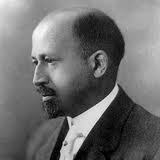
A Walking Tour of Relevant Sites
W.E.B. Du Bois Downtown Great Barrington Walking Tour
 A piece of our vision is to place Du Bois prominently in the downtown Great Barrington landscape through signage at places significant to Du Bois as a youth and in later life. While many of the building sites no longer exist, there is sufficient historical information to tell a unique story at each site. Currently, W.E.B. Du Bois in Great Barrington is a self-guided walking and motor tour, and we plan to enhance it with signage marking each location as well as adding an audio guide.
A piece of our vision is to place Du Bois prominently in the downtown Great Barrington landscape through signage at places significant to Du Bois as a youth and in later life. While many of the building sites no longer exist, there is sufficient historical information to tell a unique story at each site. Currently, W.E.B. Du Bois in Great Barrington is a self-guided walking and motor tour, and we plan to enhance it with signage marking each location as well as adding an audio guide.
The Du Bois in Great Barrington Walking Tour brochure is available at the Chamber of Commerce kiosk on lower Main Street, at the kiosk next to the Post Office on upper Main Street, or by emailing us at: Info@HousatonicHeritage.org.
Great Barrington Walking Tour Brochure PDFs:
- W.E.B. Du Bois Walking Tour – Brochure P.1
- W.E.B. Du Bois Walking Tour – Brochure P.2
- W.E.B. Du Bois Walking Tour – Brochure Map
Great Barrington Walking Tour Videos:
These narrated videos were recorded at many of the sites on the Walking Tour.
Searles School in Great Barrington:
Du Bois River Garden Park:
Du Bois Homesite:
First Congregational Church of Great Barrington:
Clinton AME Zion Church – 9 Elm Court, Great Barrington:
Du Bois Birthsite – Church St. Great Barrington:
Great Barrington Town Hall:
W.E.B. Du Bois Homesite
 In Great Barrington, Massachusetts, the Homesite—a sacred place—holds a deep history of Du Bois’s ancestry going back to the early 1800s and is a place of contemplation and commemoration. The existing woodland interpretive trail will be expanded to illuminate more about Du Bois’s journey from this small rural farming community to world prominence. A “living memorial” with ongoing archaeological investigations, the site has yielded discoveries about the daily life of Du Bois’s ancestors. Future digital technology will provide further opportunities for enriching the archaeological interpretation.
In Great Barrington, Massachusetts, the Homesite—a sacred place—holds a deep history of Du Bois’s ancestry going back to the early 1800s and is a place of contemplation and commemoration. The existing woodland interpretive trail will be expanded to illuminate more about Du Bois’s journey from this small rural farming community to world prominence. A “living memorial” with ongoing archaeological investigations, the site has yielded discoveries about the daily life of Du Bois’s ancestors. Future digital technology will provide further opportunities for enriching the archaeological interpretation.
Future plans for the Homesite include an outdoor amphitheater and gathering space, which will accommodate up to 50 people. In addition, we plan to expand the parking area and build an interpretive shelter that includes bathroom facilities.
Visit the Du Bois Homesite
Presently, visitors can experience a self-guided interpretive trail at the W.E.B. Du Bois Homesite in a rural setting two miles from downtown Great Barrington. The interpretive trail highlights Du Bois’s journey from Great Barrington to the world stage, information from ongoing archaeological excavations, as well as the Homesite dedication in 1969. Visitors can also explore Du Bois’s legacy in the landscape of downtown Great Barrington. Take the W.E.B Du Bois in Great Barrington Walking Tour to learn about places and people important to Du Bois.
Free Guided Walking Tours at the W.E.B. Homesite, 2018
- June 30 through September 1
- Saturdays at 11 AM, 1 PM, 2 PM.
- Group tours will also be available on other days and times by appointment.
- The tour is about 50 minutes long, and follows a loop wooded trail that takes visitors to the remains of Du Bois’s ancestral home where visitors will learn about Du Bois’s family and way of life as revealed through archaeological investigations and historic documents. Along the way, visitors will learn about Du Bois’s journey from Great Barrington to the world stage, as well as the site’s beginnings as a memorial.
- Meet at the Homesite parking area. Please note, presently there are no bathroom facilities at the Homesite.
- For questions or group bookings: Email info@duboisnhs.org or (413) 717-6259.
About WEB Du Bois
 W. E. B. Du Bois was born just five years after Lincoln signed the Emancipation Proclamation. This valedictorian of Great Barrington High School became the first African American to earn a Ph.D. at Harvard, lived and worked on three continents, was a founder of the NAACP and edited its Crisis magazine for nearly a quarter century. Such groundbreaking books as The Souls of Black Folk, The Philadelphia Negro, and Black Reconstruction helped to transform the study of African American history and to establish sociology as an academic discipline.
W. E. B. Du Bois was born just five years after Lincoln signed the Emancipation Proclamation. This valedictorian of Great Barrington High School became the first African American to earn a Ph.D. at Harvard, lived and worked on three continents, was a founder of the NAACP and edited its Crisis magazine for nearly a quarter century. Such groundbreaking books as The Souls of Black Folk, The Philadelphia Negro, and Black Reconstruction helped to transform the study of African American history and to establish sociology as an academic discipline.
Du Bois is widely credited as the father of both the modern civil rights movement in the U.S. and the Pan-African movement internationally. Du Bois’ political interests date back to his teen-age years in Great Barrington when he served as a correspondent for the Philadelphia Courier reporting on the political happenings of the town. His interest in history began when he devoured the texts of the early historians and philosophers at the local bookstore.

